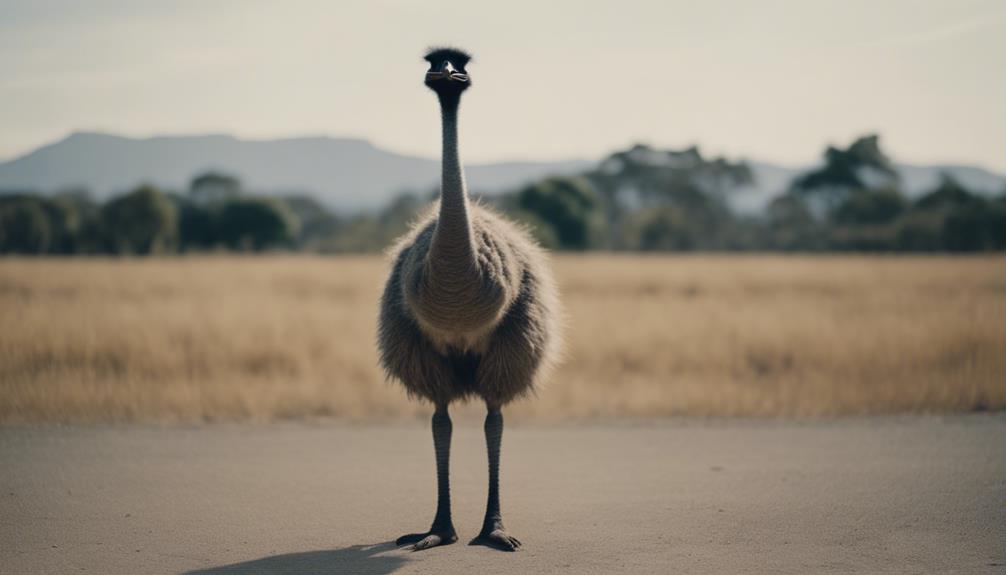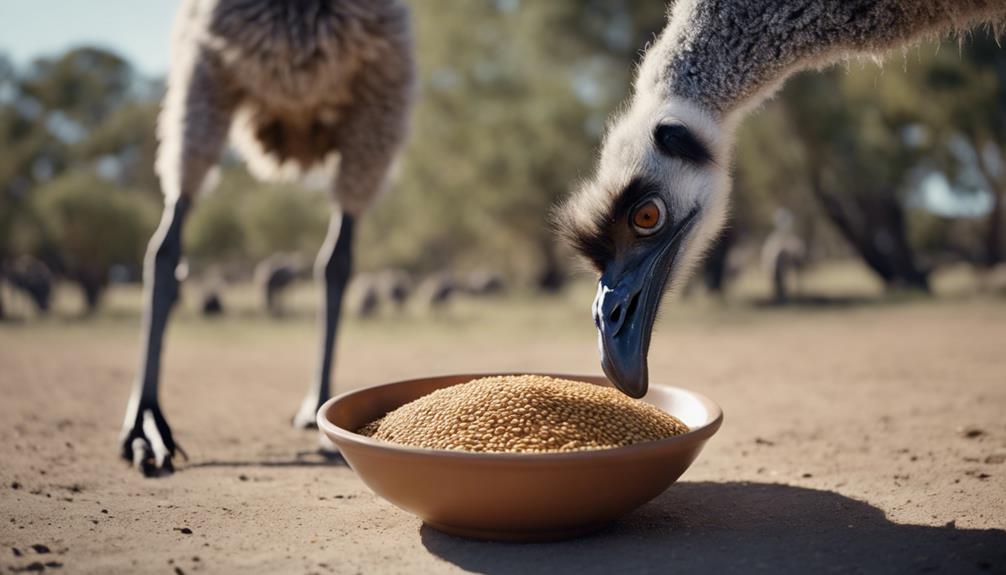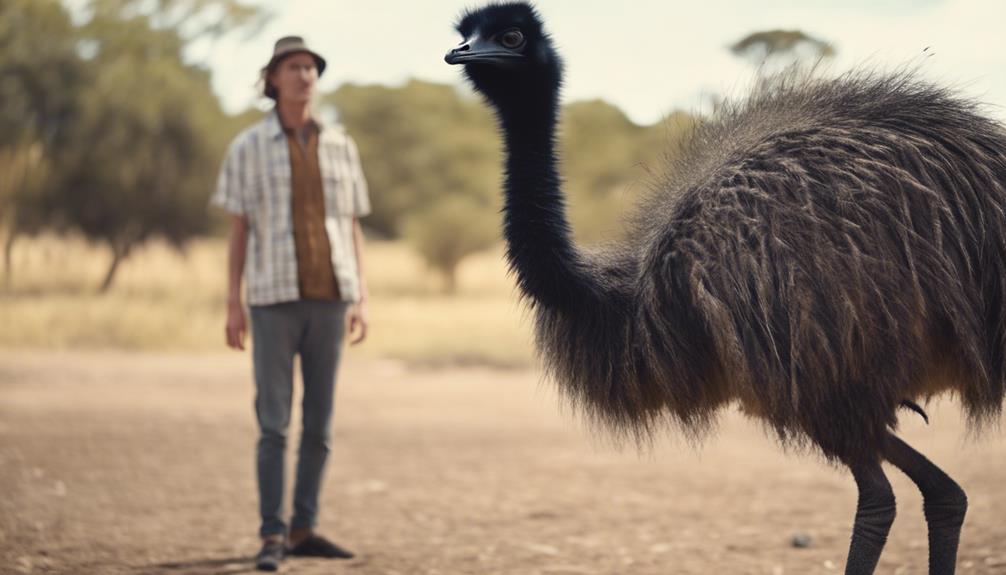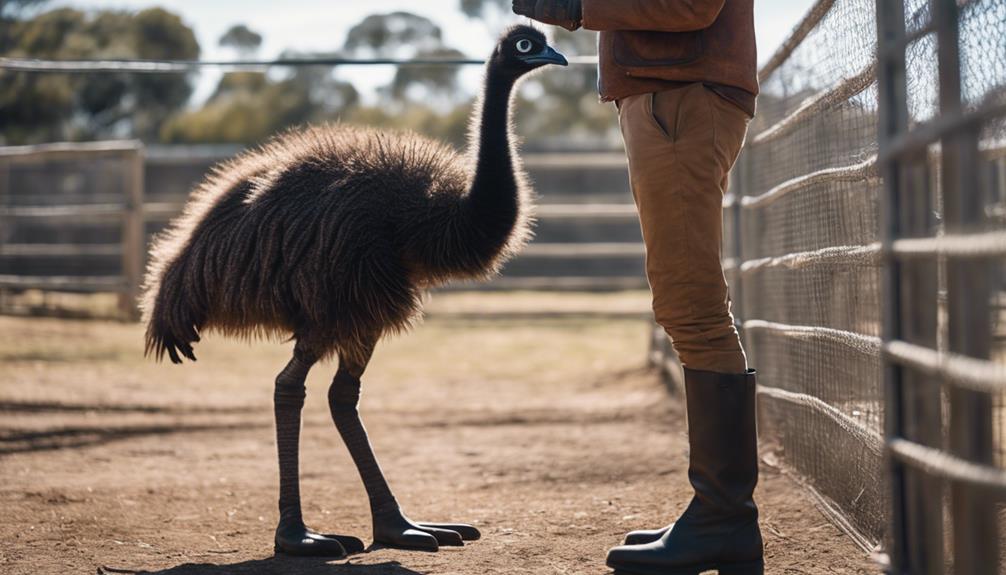
When it comes to handling and interacting with emus, remember that these majestic birds symbolize both grace and strength in the Australian landscape.
Understanding their behavior and body language is crucial in ensuring your safety and theirs.
But what are the key steps to take when approaching these fascinating creatures?
Let's explore the dos and don'ts to establish a harmonious relationship with emus, ensuring a positive experience for both parties involved.
Key Takeaways
- Respect emus' behavior cues and communication signals for safe interaction.
- Avoid triggering aggression by understanding their body language and needs.
- Build trust through gradual approach, gentle movements, and consistent interactions.
- Ensure proper care, habitat, and nutrition for emus' welfare and well-being.
Emu Behavior and Body Language

When observing emus, notice how their body language and behavior provide valuable insights into their mood and intentions. Emus communicate through a variety of behavior cues and interaction signals. For example, when an emu approaches you with its head held high and feathers slightly puffed up, it's likely feeling curious or interested in its surroundings. On the other hand, if an emu lowers its head and makes a soft drumming sound, it may be signaling a friendly greeting.
Body language interpretation is crucial when interacting with emus. If an emu leans away from you or pecks at the ground, it might be indicating discomfort or unease. In contrast, if it approaches you with a relaxed posture and pecks gently at your hand, it's likely seeking attention or food. Understanding these subtle cues can help you build a positive relationship with these fascinating birds.
Emus also use vocalizations and movements to convey their emotions. By paying attention to their body language and behavior, you can better understand and respond to their needs, fostering a harmonious interaction between you and these majestic creatures.
Understanding Emu Aggression Triggers
Understanding common triggers for emu aggression is essential for safely interacting with these large birds. Emus, although generally docile, can become aggressive if they feel threatened or stressed. Recognizing warning signs and knowing how to manage their behavior can help prevent potentially dangerous situations. Here are some key factors to consider:
- Protecting their territory: Emus are territorial creatures and may become aggressive if they feel their space is being invaded.
- Feeling cornered or trapped: When emus feel trapped or cornered, they may lash out in self-defense.
- Protecting their young: Like many animals, emus are fiercely protective of their offspring and may exhibit aggression if they perceive a threat to their chicks.
- Unexpected loud noises: Sudden loud noises can startle emus, triggering a defensive response.
- Direct eye contact: Staring directly into an emu's eyes can be perceived as a threat, potentially leading to aggressive behavior.
Approaching Emus Safely

To approach emus safely, it's crucial to understand their body language and maintain a respectful distance to avoid triggering any potential aggression. Emus, native to Australia, are often found in various habitats such as forests, savannas, and grasslands. When approaching an emu, it's essential to be aware of their communication cues. These large flightless birds use a range of signals to express their emotions and intentions.
Emus may indicate their comfort or discomfort through subtle movements like tilting their head or changing their posture. Observing these behaviors can help you gauge whether it's appropriate to approach them or give them space. When near emus, avoid sudden movements or loud noises that could startle them. Maintaining a safe distance and moving slowly can help prevent any potential misunderstandings or conflicts. By respecting their space and paying attention to their signals, you can establish a harmonious interaction with these fascinating creatures.
Establishing Trust With Emus
Establishing trust with emus requires consistent and patient behavior to build a positive and secure relationship with these birds. To gain their trust and build rapport effectively, consider the following:
- Respect Their Space: Allow emus to approach you on their terms, avoiding sudden movements that may startle them.
- Use Gentle Gestures: Slow, deliberate movements and calm demeanor can help emus feel more comfortable around you.
- Offer Treats Slowly: If feeding is appropriate in your situation, offer treats like grains or fruits gradually to show kindness and build trust.
- Spend Time Around Them: Emus are observant creatures, so spending time near them without direct interaction can help them get used to your presence.
- Consistency is Key: Emus respond well to routine, so maintaining a consistent approach in your interactions will help in building a trusting relationship with these fascinating birds.
Feeding Emus Responsibly

When feeding emus, it's crucial to provide a balanced diet that meets their nutritional needs for optimal health and well-being. Emus are omnivores, so their diet should consist of a variety of foods. Offer them a mix of fruits, vegetables, seeds, and insects to ensure they receive the proper feeding they require. Emu nutrition is essential for their growth and overall health, so make sure to provide a diet rich in vitamins, minerals, and proteins.
To feed emus responsibly, you can offer them leafy greens like kale and spinach, along with fruits such as apples and berries. Additionally, seeds like sunflower and pumpkin seeds can be a great source of nutrients for these birds. It's important to avoid feeding them processed foods, high-sugar treats, or foods that are toxic to birds.
Handling Emus With Care
Feeding emus responsibly ensures their well-being; now let's focus on handling these birds with care. When interacting with emus, it's crucial to employ proper emu handling techniques and follow essential emu care tips to ensure the safety of both yourself and the birds. Here are some key points to keep in mind:
- Approach Calmly: Emus are sensitive to sudden movements. Approach them calmly and avoid making loud noises.
- Watch Their Body Language: Emus communicate through body language. Be attentive to their signals to gauge their comfort level.
- Avoid Cornering Them: Emus can become agitated if they feel cornered. Allow them space to move freely.
- Use Slow Movements: When touching or feeding emus, move slowly and gently to prevent startling them.
- Respect Their Space: Emus appreciate their personal space. Avoid crowding or getting too close to them.
Emu Encounters in the Wild

To safely encounter emus in the wild, it's essential to understand their natural behaviors and habitats. Emu watching and photography can be rewarding, but it's crucial to respect the emus' space to avoid causing stress. Emus are typically found in open grasslands, savannas, and forests, so exploring these areas may increase your chances of a successful encounter.
When observing emus in the wild, try to maintain a safe distance to prevent disturbing them. Remember that emus are wild animals and may react unpredictably if they feel threatened. Additionally, ensure that your activities don't interfere with emu conservation and preservation efforts.
Creating a Secure Emu Environment
Creating a secure environment for emus requires proper fencing and shelter to ensure their safety and well-being. When designing the habitat for emus, consider the following:
- Emu Habitat Construction: Emus need ample space to roam and exercise. Build a habitat that mimics their natural environment, including sandy areas for dust bathing and vegetation for foraging.
- Emu Fencing Design: Emus are strong and can jump high. Use fencing at least 5 to 6 feet tall, with no gaps they can squeeze through. Ensure the fencing is sturdy to withstand their pecking and pushing.
- Shelter: Provide shelter such as a simple three-sided structure to protect them from extreme weather conditions like heat and rain.
- Water Source: Emus need access to clean water at all times. Ensure a secure water source within their habitat.
- Perimeter Check: Regularly inspect the fencing and perimeter for any signs of wear or damage to prevent escapes and keep emus safe and secure.
Emu Interaction Etiquette

When interacting with emus, always approach them calmly and maintain a respectful distance to prevent any potential agitated responses. Proper emu handling is crucial to ensure both your safety and the well-being of the emus.
Emus are wild animals and may perceive sudden movements or loud noises as threats. To communicate effectively with emus, use gentle body language and avoid direct eye contact, as they may interpret this as a challenge. Emus are known to communicate through vocalizations, such as booming sounds, hisses, and grunts. Understanding these communication techniques can help you interpret their moods and respond accordingly.
Educating Others About Emus
When educating others about emus, emphasize their unique physical characteristics, behavioral patterns, and natural habitat to enhance understanding and appreciation of these fascinating birds. Emus are intriguing creatures with much to learn about. Here are some key points to help you educate others:
- Emu Conservation Efforts: Discuss the importance of protecting emus in their natural habitats and the various conservation programs in place to ensure their survival.
- Emu Body Language Communication: Explain how emus communicate through their body language, such as puffing themselves up to appear larger or using low-frequency sounds to signal danger.
- Distinct Physical Characteristics: Point out their long necks, powerful legs, and distinct feathers that set them apart from other birds.
- Behavioral Patterns: Highlight their nomadic lifestyle, mating behaviors, and unique nesting habits to showcase their adaptive nature.
- Natural Habitat: Describe the environments where emus thrive, from grasslands to forests, and how they've adapted to various ecosystems.
Emu Safety Measures

To ensure a safe and harmonious interaction with emus, understanding and implementing proper safety measures is imperative. When handling emus, it's crucial to be trained in appropriate emu handling techniques. Training programs can provide valuable insights into how to approach, restrain, and care for these unique birds safely. Emus are large and powerful animals, so knowing how to handle them correctly is essential for both your safety and their welfare.
Emu care is a significant aspect of ensuring safety around these birds. Understanding their behavior and needs can help prevent potential accidents or stress for the emus. Welfare concerns should always be a top priority when interacting with these animals. Providing a suitable environment, proper nutrition, and respectful handling are key factors in promoting the well-being of emus.
Respecting Emus' Natural Habits
Respect the natural habits of emus by observing their behaviors in their native environment closely. Emu watching can provide valuable insights into these majestic birds and help in their conservation. Here are some key points to consider when respecting emus' natural habits:
- Emus are nomadic creatures, constantly on the move in search of food and suitable habitats.
- They're excellent swimmers and may be found near water sources such as rivers, lakes, or ponds.
- Emus are social animals, often seen in small groups or pairs, displaying strong familial bonds.
- These birds are diurnal, meaning they're most active during the day and rest at night.
- Habitat preservation is crucial for emus' survival, as they require vast areas to roam freely and thrive.
Frequently Asked Questions
How Often Should Emus Be Groomed or Cleaned?
To keep emus well-groomed, regularly brush them during shedding seasons. Use gentle strokes to remove old feathers and dirt. Emus shed feathers twice yearly. Cleaning with a soft brush or damp cloth helps maintain their hygiene.
Can Emus Be Trained to Perform Tricks or Tasks?
You can train emus to perform tricks or tasks using positive reinforcement methods. By understanding their behavioral cues and offering rewards, you can overcome challenges. Emus are intelligent creatures capable of learning and interacting.
Are There Any Specific Health Concerns or Diseases to Watch Out for in Emus?
Emu health is crucial, with disease risks like avian influenza or intestinal parasites. Breeding patterns impact genetic diversity. Behavior studies reveal social dynamics. Monitor their health regularly, consult a vet, and prioritize their well-being.
What Type of Enrichment Activities Can Be Provided for Emus in Captivity?
To keep your emus happy, try varied feeding methods and provide enrichment toys for mental stimulation. Engage in behavioral training and encourage social interactions to promote their well-being and overall health in captivity.
How Do Emus Communicate With Each Other and With Humans?
When it comes to how emus communicate, their vocalizations and body language play a crucial role. Through these cues, emus convey emotions, establish social hierarchies, and interact with humans, showcasing their complex and intriguing communication abilities.
Conclusion
In conclusion, interacting with emus can be a rewarding experience if done safely and respectfully. By understanding their behavior and body language, you can establish trust and avoid triggering aggression. Remember to approach them calmly, feed them responsibly, and educate others about proper etiquette.
Treat emus with the same care and respect as you'd a delicate ecosystem, delicate as a fragile glass sculpture in a museum. Embrace their natural habits and observe them from a respectful distance to ensure their well-being.




